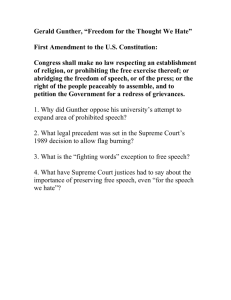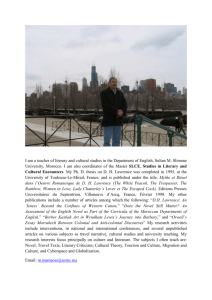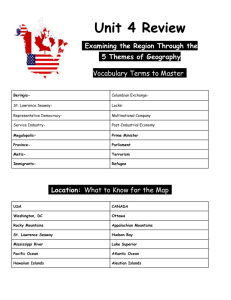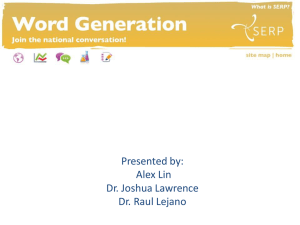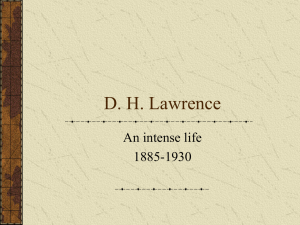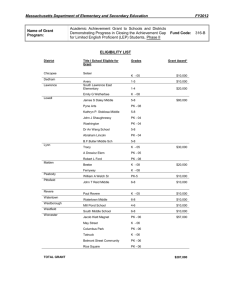PDF 433 ko
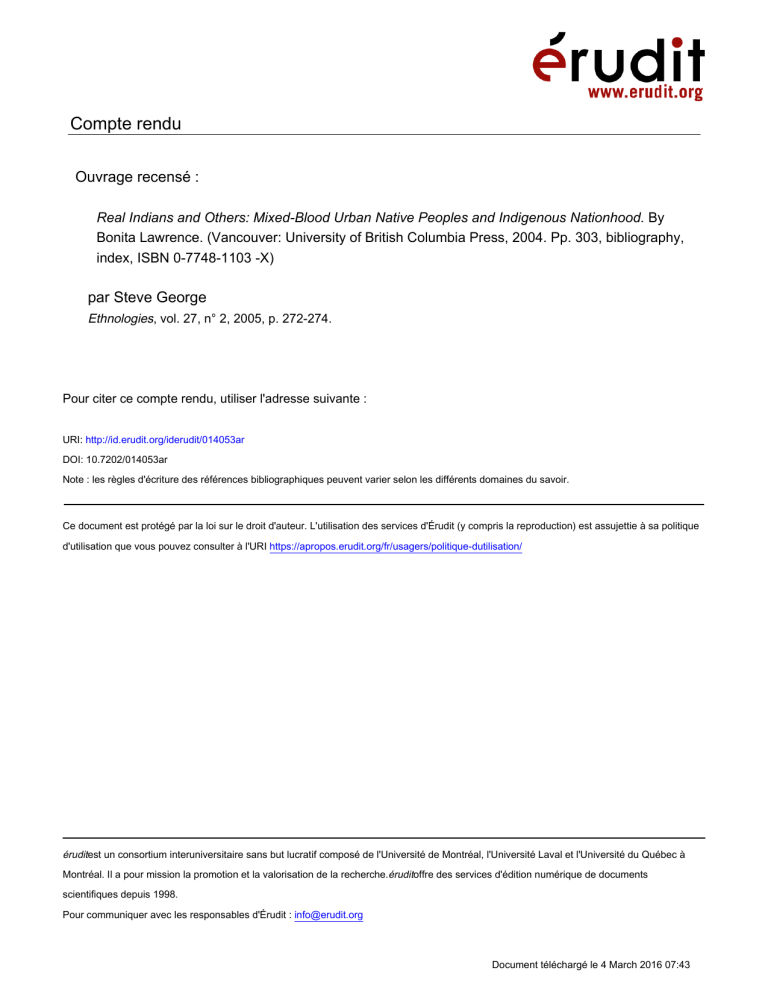
Compte rendu
Ouvrage recensé :
Real Indians and Others: Mixed-Blood Urban Native Peoples and Indigenous Nationhood. By
Bonita Lawrence. (Vancouver: University of British Columbia Press, 2004. Pp. 303, bibliography, index, ISBN 0-7748-1103 -X)
par Steve George
Ethnologies, vol. 27, n° 2, 2005, p. 272-274.
Pour citer ce compte rendu, utiliser l'adresse suivante :
URI: http://id.erudit.org/iderudit/014053ar
DOI: 10.7202/014053ar
Note : les règles d'écriture des références bibliographiques peuvent varier selon les différents domaines du savoir.
Ce document est protégé par la loi sur le droit d'auteur. L'utilisation des services d'Érudit (y compris la reproduction) est assujettie à sa politique d'utilisation que vous pouvez consulter à l'URI https://apropos.erudit.org/fr/usagers/politique-dutilisation/
éruditest un consortium interuniversitaire sans but lucratif composé de l'Université de Montréal, l'Université Laval et l'Université du Québec à
Montréal. Il a pour mission la promotion et la valorisation de la recherche.
éruditoffre des services d'édition numérique de documents scientifiques depuis 1998.
Pour communiquer avec les responsables d'Érudit : info@erudit.org
Document téléchargé le 4 March 2016 07:43
272 REVIEWS / COMPTES RENDUS
Real Indians and Others: Mixed-Blood Urban Native Peoples and
Indigenous Nationhood. By Bonita Lawrence. (Vancouver: University of British Columbia Press, 2004. Pp. 303, bibliography, index, ISBN 0-
7748-1103 -X)
The title of Lawrence’s book is as direct as it is provocative. The book’s title states the book’s purpose to examine the central and perhaps most volatile question in Aboriginal communities today: “Who is an
Indian ?
” In 2003, Lawrence edited Strong Women Stories: Native Vision and Community Survival (Sumach Press) with Kim Anderson and in many respects this new work is a continuation of the voices heard in that book. Lawrence is a Mi’kmaq scholar whose research at Queen’s
University, and more recently at York University, has concerned how
“Indian/nativeness” is defined in Euro-Canadian and Native contexts, from within historical and legal paradigms as well as within native communities across Canada.
Bonita Lawrence’s work is a continuation of powerful works like
Howard Adams’ Prison of Grass (1975) and Maria Campbell’s Half-
Breed (1973) and more recent works by Joseph Bruchac, Bowman’s
Store (Lee & Low Books, 2001) and Warren Carriou’s, Lake of the Prairies
(Anchor, 2003). It has the depth of these works because we read mixedblood peoples’ voices directly from the page. The importance of these voices lies in how each of these persons tells their stories, relates their experiences, and shares their family and community histories. Lawrence’s style of writing is easy to read while her research approach is organic in its having informants speak for themselves.
As a mixed-blood Mi’kmaw, I read this book from both a very personal level of experience as well as from an academic one, as a
Masters graduate student in Folklore. In Canada the subject of mixedblood Native people remains a controversial one from within native communities and from without, in the large urban centres across the country. Lawrence has interviewed several mixed-blood informants to tell stories that show the different kinds of experiences mixed-bloods have had in the city of Toronto and across North America. Some of these narratives involve pain, abuse, neglect, and lack of self worth, while others involve stories of empowerment, community involvement, and survival. Each one of the informants speaks from life experiences that involve a mix of acceptance and non-acceptance of their “Indian/ nativeness,” both from within themselves, from their families as well as
REVIEWS / COMPTES RENDUS 273 from different native communities. The responses interviewees give
Lawrence are direct and bear fruit to the underreported and underwritten subject of mixed-blood Native peoples.
If the following questions have ever interested you then this is the book to read. Who is native and who is not native? Where do mixedblood native people fit within Aboriginal and Canadian society? Who or what processes determine a person’s “Indian/nativeness”? Are mixedbloods really native? Or are they just in a “wanna-be Indian” category?
These are just some of the many incendiary questions Lawrence sifts through in her analysis of the social, legal, and political discussions of mixed blood native peoples in Canada. Lawrence’s work provides an authoritative examination of the seminal issues involved in the lives of non-status Indian, Métis and disenfranchised native peoples.
Identity is such a basic and yet fundamental part of being human.
Identity allows each of us to have the clarity of saying who we are and where we came from while an identity provides us with particular spaces to call our own. Most Canadians would take for granted the right to live in the community in which they reside. However, for many mixedblood Natives the right to identify through community membership, or to call a reserve “home” has been taken away by either the federal government, the local band council or through a series of historical events. Lawrence delves deep into the fray here. She is critical of Native scholars like Taiaiake Alfred, who in arguing for a community’s right to decide who should be on its membership rolls have tended to reinforce sexist, racist and colonialist interpretations on membership through flawed processes like blood quantum.
Very deftly, Lawrence argues that native communities have a right to determine their members, but that process should recognize the divisive and destructive influence the Indian Act has had in the past.
Lawrence is open to communities recognizing their mixed-blood members today as well as in the past, rather than treating this fact as a dirty secret. Lawrence argues that mixed-bloods, off reserve, and status
Indians on reserve, have suffered equally from the effects of a paternalistic colonialism that has consistently divided the wider polity of Native people in Canada into the ridiculous categories of status and non-status
Indians. Band councils that decide to create strict membership codes will reinforce old wrongs rather than change them. Here, Leroy Little
274 REVIEWS / COMPTES RENDUS
Bear’s caveat comes to mind, that in fifty to seventy-five years there will be no status Indians left in Canada but the Indian Act will endure.
Steve George
Memorial University
St. John’s, Newfoundland
References
Adams, Howard. 1989. Prison of Grass: Canada from a Native Point of
View . Saskatoon: Fifth House Publishers.
Bruchac, Joseph. 2001. Bowman’s Store: A Journey to Myself . New York:
Lee & Low Books.
Campbell, Maria. 1983. Half-Breed . Halifax: Goodread Biographies.
Carriou, Warren. 2003. Lake of the Prairies: A Story of Belonging.
Toronto:
Anchor Canada.
King, Thomas. 2003. The Truth About Stories: A Native Narrative.
Toronto: Anansi.
Kim Anderson and Bonita Lawrence, eds. 2003. Strong Women Stories:
Native Vision and Community Survival. Toronto: Sumach Press.
Deep Listeners: Music, Emotion, and Trancing. By Judith Becker.
(Bloomington and Indianapolis: Indiana University Press, 2004. Pp.
xii+194, notes, bibliography, index, compact disc, ISBN 0-253-34393-3, cloth.)
Contemporary Western ideas surrounding trance are linked to stereotypes and entrenched models. Generally, trancers are people who lived before (i.e., the distant past, the Age of Enlightenment, the nineteenth and twentieth centuries), or, in current contexts, trancers are people who exist on the fringes of global societies (i.e., they practice marginalized religions, suffer from emotional or mental instability, or are attention seekers). An important part of this modeling is that trancing is often and typically gendered (i.e., practiced mainly by women). In
Deep Listeners: Music, Emotion, and Trancing, Judith Becker explores connections between neuroscience and music rituals in different world contexts, thereby dispelling many of the myths that surround trancing, as well as demonstrating the multiple roles that music plays in trancing rituals. Largely due to Becker’s work, trancing is a new domain in
